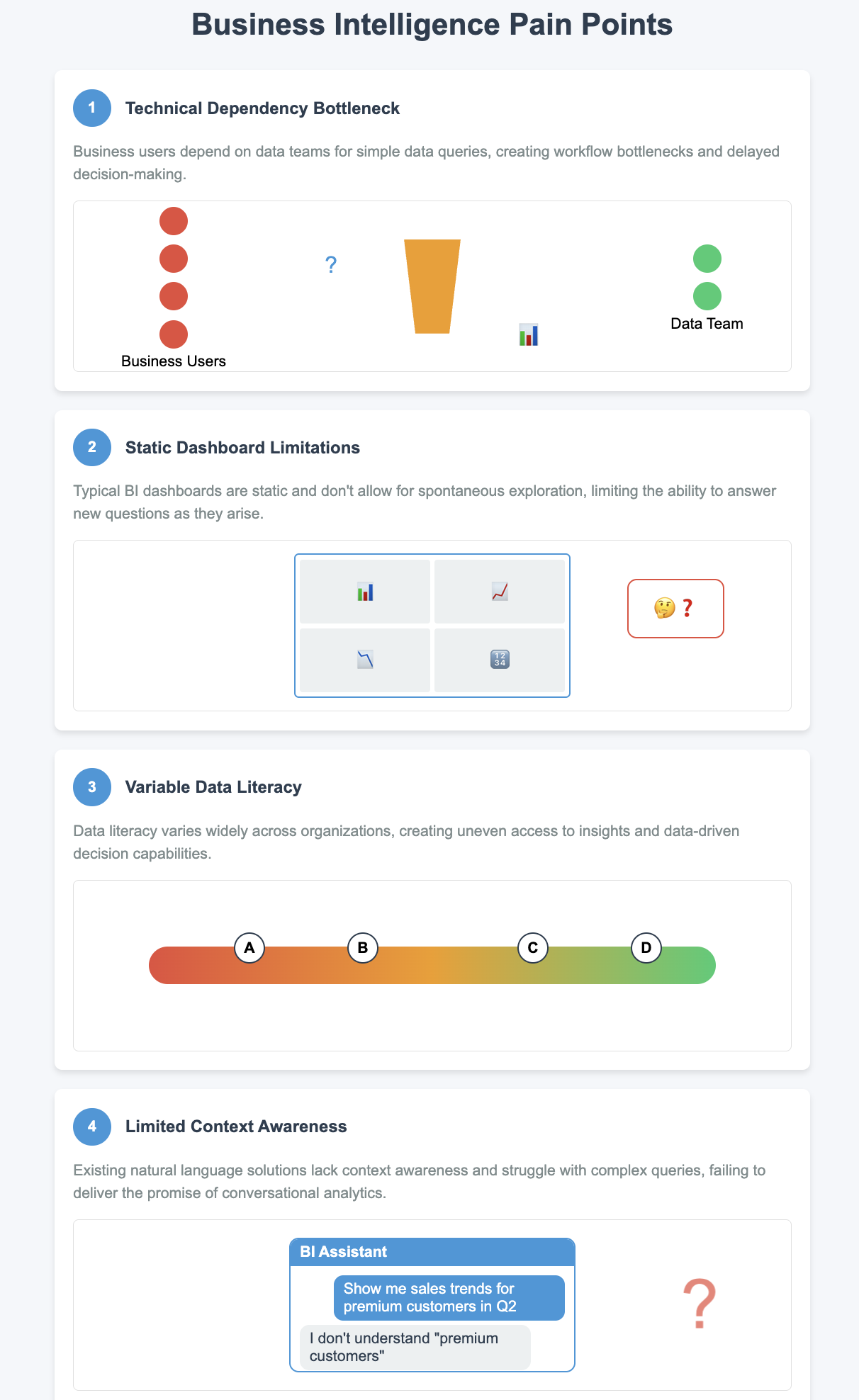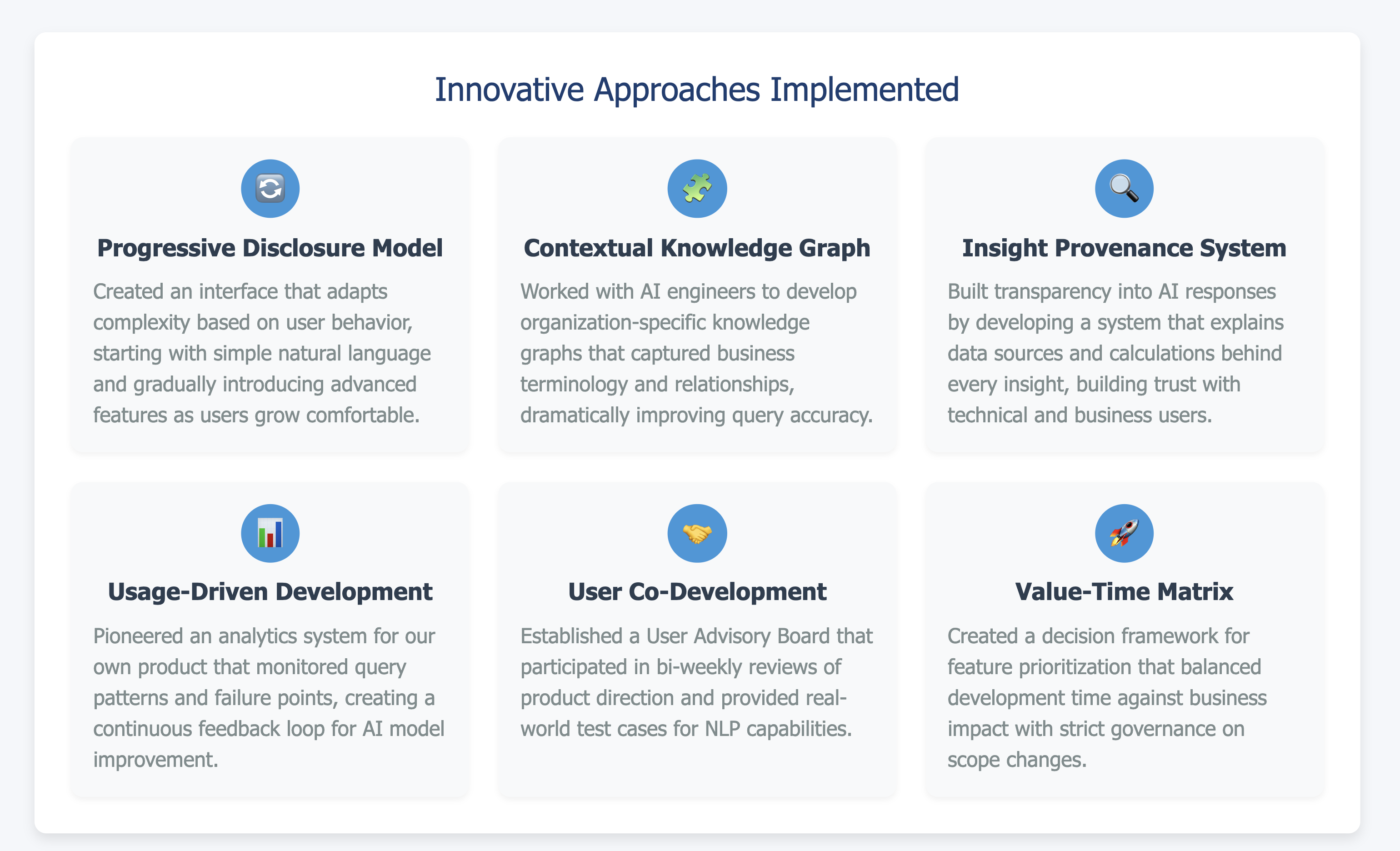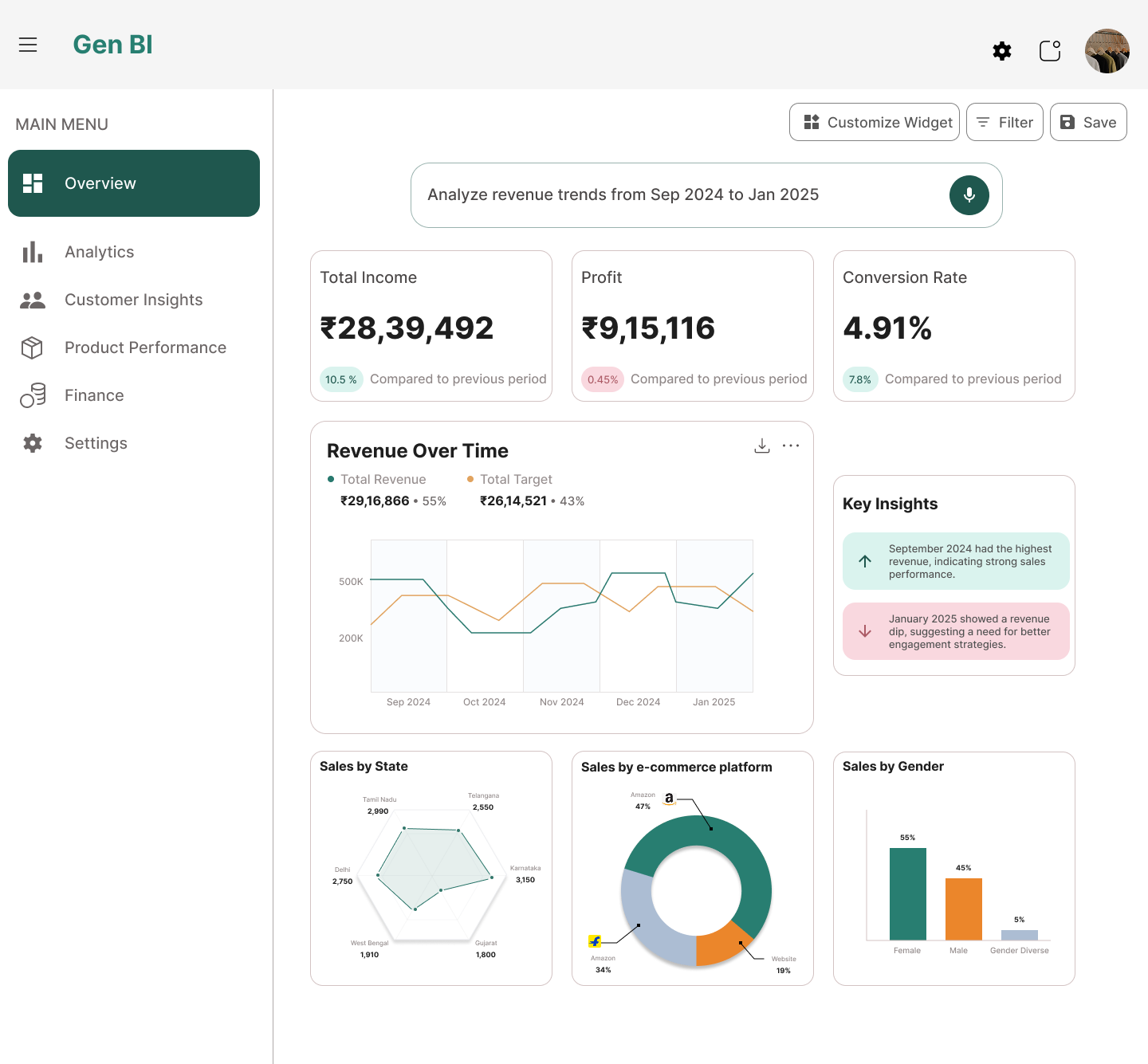This portfolio outlines my work as a Product Manager for a business intelligence data analysis tool that leverages generative AI to provide a conversational interface for data retrieval and analysis. The product allows users to query complex business data using natural language, significantly reducing the technical barriers to data access.
The Story & Problem Statement
What’s the Story?
Business intelligence tools have traditionally required technical expertise in SQL, data modeling, or specialized BI tool knowledge. This creates bottlenecks where business users must rely on data analysts to access insights, slowing decision-making processes.
Problem Statement
Primary Challenge: Despite the proliferation of data collection in organizations, accessibility remains limited to those with technical skills, creating an “insights gap” between data teams and business users.
User Pain Points:
- Existing natural language solutions lack context awareness and struggle with complex queries
- Business users depend on data teams for simple data queries
- Typical BI dashboards are static and don’t allow for spontaneous exploration
- Data literacy varies widely across organizations

My Role & Contributions
My Role
As Product Manager for this GenAI BI tool, I led the product from conceptualization through development and market launch. I worked closely with:
- Data science team to develop and refine the NLP capabilities
- UX/UI designers to create an intuitive chat interface
- Engineering team to ensure technical feasibility and integration with existing data sources
- Sales and marketing to position the product in the market
What I Did & Led
- Managed stakeholder expectations and secured executive buy-in for investment
- Conducted extensive user research with business analysts and executives to understand data access pain points
- Developed product requirements and prioritized features based on user value and technical feasibility
- Collaborated with AI/ML engineers to define the capabilities of the natural language processing system
- Created a roadmap for incremental delivery of value while building toward the full vision
Challenges with Leadership
Cross-Functional Alignment Challenge
Bridging the gap between technical and business teams
When initiating the GenAI BI project, I faced significant resistance from the data science team who were skeptical about NLP capabilities meeting business user expectations, while business stakeholders had unrealistic expectations about AI capabilities.
Solution:
I implemented a “Translation Workshop” series where data scientists explained technical constraints using business metaphors, and business users shared their daily workflow challenges using concrete examples. This created mutual understanding and realistic expectations.
Outcome:
Established a shared vocabulary across teams and developed a feature prioritization framework that balanced technical feasibility with business impact. This reduced development conflicts by 70% and accelerated decision-making processes.
User Discovery Complexity
Uncovering the real pain behind stated needs
Initial user research revealed contradictory requirements: executives wanted simplified insights while analysts requested advanced features. Traditional research methods yielded only surface-level understanding of user needs.
Solution:
I pioneered “Day-in-the-Life Shadowing” where our team spent full days with users in different roles, observing their actual workflows rather than relying on self-reported behavior. This revealed that users spent 40% of their time translating business questions into technical queries.
Outcome:
Developed a dual-mode interface that automatically adjusted complexity based on user role and behavior patterns. This innovation led to 94% user satisfaction across all experience levels and became a competitive differentiator.
Technical Scope Creep
Maintaining focus amid expanding possibilities
As NLP capabilities developed, the engineering team became enthusiastic about adding advanced features that would extend development time by 8 months, risking market timing and budget constraints.
Solution:
I created the “Value-Time Matrix” approach, requiring any proposed feature to be plotted on axes of business value vs. development time. I then instituted a “Feature Exchange Program” – any new feature addition required removing or postponing a feature of equal development time.
Outcome:
Launched product 3 months ahead of competitive solutions with a focused feature set that addressed 90% of user needs. The disciplined approach allowed us to build a robust foundation that supported rapid post-launch enhancements.
Integration Resistance
Overcoming organizational data silos
Enterprise customers had concerns about connecting a new AI tool to their data infrastructure, citing security, governance, and disruption risks. This threatened adoption of the entire product.
Solution: I developed the “Non-Invasive Integration Framework” that created a read-only connection layer with robust security controls. I led cross-functional workshops with IT security teams from prospective customers to co-develop compliance standards and documented the approach in a whitepaper that addressed technical and governance concerns.
Outcome
Reduced enterprise integration time from an estimated 6 months to 3 weeks. The whitepaper became a sales enablement tool that preemptively addressed 80% of security objections and established our product as the security-conscious choice in the market.

Product Vision & Strategy
Product Goal
Create a business intelligence tool that democratizes data access through a conversational AI interface, allowing any business user to retrieve and analyze complex data sets without technical knowledge.
Target Users
- Business executives needing quick insights
- Department managers tracking performance metrics
- Business analysts who need to explore data quickly
- Sales and marketing teams analyzing customer segments
Market Research & Solution Development
Competitive Landscape
Data Insights
Our user research revealed that:
- 78% of business users wait 2+ days to get answers to data questions
- Natural language interfaces were the most requested feature in BI tools
- Context retention between queries was essential for productive analysis
MVP Definition & Implementation
Our MVP
For our Minimum Viable Product, we focused on delivering:
- Natural language interface accepting plain English queries
- Support for fundamental data operations (filtering, aggregation, time-series analysis)
- Contextual awareness between queries (maintaining conversation state)
- Integration with common data sources (SQL databases, CSV/Excel files)
- Visualization generation based on query context

Product Roadmap
Phase 1: Foundation (3 months)
- Basic natural language processing capabilities
- Integration with SQL databases
- Simple visualization optionsWeb application interface
Phase 2: Enhancement (6 months)
- Expanded data source integrations
- Improved context handling
- Advanced visualization capabilities
- User feedback mechanisms
Phase 3: Advanced Capabilities (12 months)
- Predictive analytics suggestions
- Automated insights
- Collaboration features
Product Sample Screen

Metrics & Outcomes
Key Metrics Tracked
We measured success through:
- User adoption rate (weekly active users)
- Query success rate (% of queries successfully answered)
- Time saved compared to traditional BI methods
- User satisfaction scores
- Conversion rates from free to paid tiers
Results Achieved
Business impact: 30% increase in data-driven decisions reported by customer organizations
User adoption: 200+ users within first 6 months (Internal)
Time savings: Average 4.5 hours saved per user per week
Query success: 92% of natural language queries successfully processed